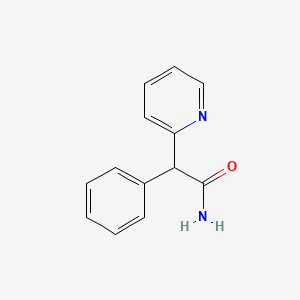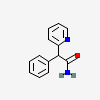2-Phenyl-2-(pyridin-2-yl)acetamide
- 7251-52-7
- 2-phenyl-2-(pyridin-2-yl)acetamide
- Phenyl-(2-pyridyl)acetamide
- 2-Phenyl-2-(2-pyridyl)acetamide
- alpha-Phenyl-2-pyridineacetamide
- Create:2005-03-26
- Modify:2025-01-11

- 7251-52-7
- 2-phenyl-2-(pyridin-2-yl)acetamide
- Phenyl-(2-pyridyl)acetamide
- 2-Phenyl-2-(2-pyridyl)acetamide
- alpha-Phenyl-2-pyridineacetamide
- 2-phenyl-2-pyridin-2-ylacetamide
- MFCD00138126
- A5VMT44Z62
- (2RS)-2-Phenyl-2-(pyridin-2-yl)acetamide
- NSC-62572
- alpha-Phenylpyridine-2-acetamide
- NSC62572
- EINECS 230-663-3
- NSC 62572
- pyridinylphenylacetamide
- CBMicro_020816
- Cambridge id 5471815
- UNII-A5VMT44Z62
- Oprea1_091075
- SCHEMBL639563
- alpha-(2-Pyridyl)phenylacetamide
- DTXSID90874398
- alpha -Phenyl-2-pyridineacetamide
- CCG-8643
- (RS)-phenyl-pyridin-2-yl-acetamide
- STL290452
- 2-phenyl-2-(pyridine2-yl) acetamide
- AKOS005065618
- CS-W015007
- AS-61754
- SC-16571
- .ALPHA.-PHENYL-2-PYRIDINEACETAMIDE
- BIM-0020905.P001
- .ALPHA.-(2-PYRIDYL)BENZENEACETAMIDE
- DB-055644
- NS00044041
- P1741
- 2-PYRIDINEACETAMIDE, .ALPHA.-PHENYL-
- H10833
- SR-01000210022
- SR-01000210022-1
- METHYLPHENIDATE HYDROCHLORIDE IMPURITY F [EP IMPURITY]

H302 (83.3%): Harmful if swallowed [Warning Acute toxicity, oral]
H315 (16.7%): Causes skin irritation [Warning Skin corrosion/irritation]
H319 (16.7%): Causes serious eye irritation [Warning Serious eye damage/eye irritation]
P264, P264+P265, P270, P280, P301+P317, P302+P352, P305+P351+P338, P321, P330, P332+P317, P337+P317, P362+P364, and P501
(The corresponding statement to each P-code can be found at the GHS Classification page.)
Aggregated GHS information provided per 6 reports by companies from 2 notifications to the ECHA C&L Inventory. Each notification may be associated with multiple companies.
Information may vary between notifications depending on impurities, additives, and other factors. The percentage value in parenthesis indicates the notified classification ratio from companies that provide hazard codes. Only hazard codes with percentage values above 10% are shown.
Acute Tox. 4 (83.3%)
Skin Irrit. 2 (16.7%)
Eye Irrit. 2 (16.7%)
Patents are available for this chemical structure:
https://patentscope.wipo.int/search/en/result.jsf?inchikey=PYAPITOPBTXXNJ-UHFFFAOYSA-N
- CAS Common ChemistryLICENSEThe data from CAS Common Chemistry is provided under a CC-BY-NC 4.0 license, unless otherwise stated.https://creativecommons.org/licenses/by-nc/4.0/α-Phenyl-2-pyridineacetamidehttps://commonchemistry.cas.org/detail?cas_rn=7251-52-7
- ChemIDplusalpha-Phenyl-2-pyridineacetamidehttps://pubchem.ncbi.nlm.nih.gov/substance/?source=chemidplus&sourceid=0007251527ChemIDplus Chemical Information Classificationhttps://pubchem.ncbi.nlm.nih.gov/source/ChemIDplus
- DTP/NCILICENSEUnless otherwise indicated, all text within NCI products is free of copyright and may be reused without our permission. Credit the National Cancer Institute as the source.https://www.cancer.gov/policies/copyright-reuse
- European Chemicals Agency (ECHA)LICENSEUse of the information, documents and data from the ECHA website is subject to the terms and conditions of this Legal Notice, and subject to other binding limitations provided for under applicable law, the information, documents and data made available on the ECHA website may be reproduced, distributed and/or used, totally or in part, for non-commercial purposes provided that ECHA is acknowledged as the source: "Source: European Chemicals Agency, http://echa.europa.eu/". Such acknowledgement must be included in each copy of the material. ECHA permits and encourages organisations and individuals to create links to the ECHA website under the following cumulative conditions: Links can only be made to webpages that provide a link to the Legal Notice page.https://echa.europa.eu/web/guest/legal-noticeα-phenylpyridine-2-acetamidehttps://chem.echa.europa.eu/100.027.876α-phenylpyridine-2-acetamide (EC: 230-663-3)https://echa.europa.eu/information-on-chemicals/cl-inventory-database/-/discli/details/30135
- FDA Global Substance Registration System (GSRS)LICENSEUnless otherwise noted, the contents of the FDA website (www.fda.gov), both text and graphics, are not copyrighted. They are in the public domain and may be republished, reprinted and otherwise used freely by anyone without the need to obtain permission from FDA. Credit to the U.S. Food and Drug Administration as the source is appreciated but not required.https://www.fda.gov/about-fda/about-website/website-policies#linking.ALPHA.-PHENYL-2-PYRIDINEACETAMIDEhttps://gsrs.ncats.nih.gov/ginas/app/beta/substances/A5VMT44Z62
- EPA DSSToxalpha-(2-Pyridyl)phenylacetamidehttps://comptox.epa.gov/dashboard/DTXSID90874398CompTox Chemicals Dashboard Chemical Listshttps://comptox.epa.gov/dashboard/chemical-lists/
- Japan Chemical Substance Dictionary (Nikkaji)
- Springer Nature
- Wikidataalpha-(2-Pyridyl)phenylacetamidehttps://www.wikidata.org/wiki/Q82855587
- Wiley
- PubChem
- GHS Classification (UNECE)GHS Classification Treehttp://www.unece.org/trans/danger/publi/ghs/ghs_welcome_e.html
- NORMAN Suspect List ExchangeLICENSEData: CC-BY 4.0; Code (hosted by ECI, LCSB): Artistic-2.0https://creativecommons.org/licenses/by/4.0/NORMAN Suspect List Exchange Classificationhttps://www.norman-network.com/nds/SLE/
- MolGenieMolGenie Organic Chemistry Ontologyhttps://github.com/MolGenie/ontology/
- PATENTSCOPE (WIPO)SID 389229759https://pubchem.ncbi.nlm.nih.gov/substance/389229759

